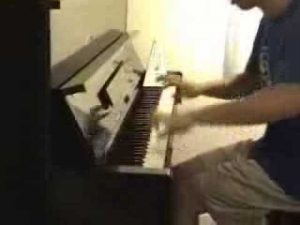Découvrez la vidéo Mario & Luigi: Bowser's Inside Story - Final Battle de Video Game Pianist sur Le Fil YouTube de Piano Partage.
I perform Mario & Luigi: Bowser's Inside Story - Final Battle!
Music composed by Yoko Shimomura. Final Battle was requested by Justine D. in the 3 June 2013 video.
My repertoire list: http://videogamepianist.com/repertoire/
Please enjoy my Super Mario Medley performance! http://www.youtube.com/watch?v=dFZki6TcY4w
Also, please click here to subscribe! http://www.youtube.com/subscription_center?add_user=mmleung
Google+: http://plus.google.com/+Videogamepianist
Twitter: http://www.twitter.com/vidgamepianist
Facebook: http://www.facebook.com/martinleungmusic
Official web site: http://www.videogamepianist.com
Let's identify and examine the compositional techniques Yoko Shimomura uses in Mario & Luigi: Bowser's Inside Story - Final Battle to enhance the gameplay and visuals! Please refer to the gameplay video http://www.youtube.com/embed/jFHL3l3uiow#t=2m28s and Mario & Luigi: Bowser's Inside Story - Final Battle sheet music http://www.videogamepianist.com/sheetmusic/marioandluigi_bowsers_inside_story_final_battle.pdf .
Shimomura-san creates a passionate and powerful piece to accompany the epic Bowser battle. By doing so, she incorporates motives from previous Super Mario battle themes composed by Koji Kondo. A slight use of a motive or idea will convey the character of Super Mario music. For example, many Super Mario themes in the more recent games quote previous Mario music. Mario character is skillfully conveyed from Mario themes that many people are familiar with.
Super Mario battle music is characterized by the prominent use of perfect fourths. This interval is prominent in themes such as the Super Mario Bros. 2 Boss Theme, Super Mario Bros. 2 Final Battle. Super Mario Bros. 3 Boss Battle, Super Mario World Final Battle, Super Mario World 2 Boss Theme, Super Mario World 2 Giant Baby Bowser Theme, and more. Shimomura-san uses the perfect fourth interval in measure 7 to begin the melody. When the player listens to this portion, and if the player is familiar with previous Super Mario battle themes, the player gets a sense that this is battle theme.
Shimomura-san also uses the interval of the fourth in the bass line and thereby builds stronger associations to previous Super Mario battles. For example, there is the descending G# - F# - E - D# tetrachord starting at measure 7. When the note D# is reached, there is an ascending tetrachord through D# - E - F# - G# starting at measure 10. The f double sharp is treated as a chromatic passing tone. At measure 35 in the treble clef there are two repetitions of a descending tetrachord. These instances show the use of the perfect fourth and their implied extra-musical associations.
The fast-paced music keeps the player engaged in this very intense Bowser battle. The many block chords are characteristic of Bowser's heavy steps.
These are some compositional techniques Shimomura-san successfully uses to enhance the gameplay and visuals.







